An Axiomatic Derivation of the Logarithmic Function as a Cardinal Utility Function on Money Income Levels ()
Suppes [7] Section 2 derives the logarithmic utility function based on a cardinal utility representation theorem ([7] Theorem 2) for a general class of preferences including non-monotonic preferences, in which individual preferences are specified by the difference comparison relation as well as the level comparison relation. Concretely, Suppes shows that the utility representation is determined unique up to positive affine transformations, which means that the derived utility function is a cardinal utility function representing the two relations simultaneously, and then the equilibria or solutions involving the cardinal properties are well-defined under the utility representation. However, Suppes ([7] Section II Hypothesis U) assumes that the utility values are proportional to the logarithmic values of income levels to determine the logarithmic utility function among the general class of utility functions3.
In this paper, without assuming such a superficial hypothesis on the derived utility values, it is shown that the representability of the two relations by logarithmic function can be characterized only by the axioms on the relations. Specifically, a pair of the relations on the alternatives is called a preference structure, and it is shown that a preference structure is represented by the logarithmic function as a cardinal utility function if and only if the preference structure satisfies the (mutually independent) three axioms: monotonicity, consistency and homogeneity axioms. The homogeneity axiom is the new axiom introduced by this paper and the monotonicity and consistency axioms are standard axioms in the cardinal utility theory based on the difference comparisons.
2. The Model and Results
We introduce some fundamental concepts and definitions used in the cardinal utility theory based on the difference comparisons and show the characterization result for the logarithmic utility function4.
2.1. The Model
The set of all possible levels of money income is the set of positive real numbers denoted by X ≡ R++. A level comparison relation R is a complete and transitive binary relation on X. The expression xRy means that x is preferred to y. The symmetric and asymmetric parts of R are denoted by I and S, respectively. A difference comparison relation R* on X is a complete and transitive quaternary relation on X. The expression (x → y)R*(z → w) means that the transition (path) from x to y is preferred to the transition from z to w. We assume that all the possible transitions (x → y) are completed for a fixed length of time interval and the underlying price vector is fixed over the time interval; otherwise, the money income levels are assumed to be adjusted suitably (PPP adjustment). The symmetric and asymmetric parts of R* are denoted by I* and S*, respectively. A preference structure on X is a pair of a level comparison relation R and a difference comparison relation R* on X. The preference structure on X is denoted by (R, R*). A preference structure (R, R*) on X is represented by a real-valued function u on X if and only if the following two assertions hold:
1)  for all
for all ,
,
2)  for all
for all . This definition implies that, for a given real-valued function u on X, there uniquely exists a preference structure (R, R*) which is represented by the function u, i.e., if
. This definition implies that, for a given real-valued function u on X, there uniquely exists a preference structure (R, R*) which is represented by the function u, i.e., if  and
and  are represented by u, then
are represented by u, then . Specifically, let
. Specifically, let  be the preference structure represented by the logarithmic function, i.e.3)
be the preference structure represented by the logarithmic function, i.e.3)  for all
for all 4)
4)  for all
for all . Since the logarithmic function is monotone, the condition 3) means that R0 is the monotone level comparison relation. For
. Since the logarithmic function is monotone, the condition 3) means that R0 is the monotone level comparison relation. For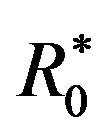 , we need a lemma proved in Appendix B:
, we need a lemma proved in Appendix B:
Lemma 1  Û (y/x)R(w/z) Û
Û (y/x)R(w/z) Û  for all
for all .
.
It follows from Lemma 1 that the condition 4) means that the difference comparison relation  is determined by the simple rule that the differences with larger growth rates are more desirable, i.e.,
is determined by the simple rule that the differences with larger growth rates are more desirable, i.e.,
 .
.
2.2. Results
We introduce the following axioms to characterize the representability of a preference structure by the logarithmic function:
Monotonicity  for all
for all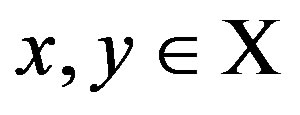 .
.
Consistency There exists some  such that
such that  for all
for all .
.
Homogeneity  for all
for all  and all t > 0.
and all t > 0.
The monotonicity axiom means that the larger levels of income are more desirable, and the consistency axiom means that there exists some  such that the difference comparison on
such that the difference comparison on  and
and  coincides with the level comparison on x and y for all
coincides with the level comparison on x and y for all . The homogeneity axiom means that two transitions are indifferent if one transition is given by multiplying a positive number both for the initial and ending levels of another transition. Then we have the following proposition:
. The homogeneity axiom means that two transitions are indifferent if one transition is given by multiplying a positive number both for the initial and ending levels of another transition. Then we have the following proposition:
Proposition Let (R, R*) be a preference structure on X and let L be a set of real-valued functions f on X defined by L = {f: there exist a > 0 and b such that  for all
for all  }. Then the following three statements are mutually equivalent:
}. Then the following three statements are mutually equivalent:
1) (R, R*) satisfies the monotonicity, consistency and homogeneity axioms;
2) (R, R*) coincides with , i.e., (R, R*) is represented by the logarithmic function;
, i.e., (R, R*) is represented by the logarithmic function;
3) (R, R*) is represented by any function in L and no function in LC represents (R, R*).
Proposition is proved in Appendix A. The three axioms in the assertion 1) of Proposition are mutually independent, which can be proved by constructing the counter examples: Define a preference structure 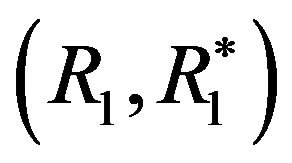 by
by

for all . The preference structure
. The preference structure  satisfies the homogeneity and consistency axioms, but it does not satisfy the monotonicity axiom, which implies that the monotonicity axiom is independent. Let
satisfies the homogeneity and consistency axioms, but it does not satisfy the monotonicity axiom, which implies that the monotonicity axiom is independent. Let  be a difference comparison relation defined by
be a difference comparison relation defined by

for all , and let
, and let  be a difference comparison relation defined by
be a difference comparison relation defined by

for all . Letting R0 be the monotonic level comparison relation again, the preference structure
. Letting R0 be the monotonic level comparison relation again, the preference structure  satisfies the monotonicity and homogeneity axioms, but it does not satisfy the consistency axiom, which implies that the consistency axiom is independent. In fact, it holds that 2S01 and
satisfies the monotonicity and homogeneity axioms, but it does not satisfy the consistency axiom, which implies that the consistency axiom is independent. In fact, it holds that 2S01 and  for all
for all . The preference structure
. The preference structure 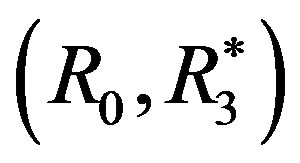 satisfies the monotonicity and consistency axioms, but it does not satisfy the homogeneity axiom, which implies that the homogeneity axiom is independent.
satisfies the monotonicity and consistency axioms, but it does not satisfy the homogeneity axiom, which implies that the homogeneity axiom is independent.
3. Conclusions
A consumer’s preferences over money income levels are specified by a level comparison relation and a difference comparison relation. A pair of the relations is called a preference structure and it is shown that a preference structure is cardinally represented by the logarithmic function if and only if the preference structure satisfies the three mutually independent axioms on the preference structures. This result clarifies the mutually independent axioms characterizing the preference structure represented by the logarithmic function as a cardinal utility function. In particular, this result enables us to interpret the per capita national income measured by the logarithmic scale as the utility level of the income, and axiomatically characterizes the simple rule evaluating the differences of per capita national income levels based on their growth rates under the monotonic level comparison relation.
Funding
The research for this paper is partially supported by Ministry of Education, Science and Culture through JSPS Grant-in-Aids for Scientific Research No. 24530191.
Appendix A
Proof of Proposition: We can easily show that the assertion 3) implies the assertion 2) and that the assertion 2) implies the assertion 1). First, we show that the assertion 1) implies the assertion 2). Suppose that (R, R*) satisfies the three axioms. By the contraposition of the monotonicity axiom that
 . (1)
. (1)
Since R is a complete and transitive binary relation on X, it holds that
 . (2)
. (2)
It holds by the monotonicity axiom and (2) that
 . (3)
. (3)
Hence it holds by (1) and (3) that
 . (4)
. (4)
Since  is increasing on X, it holds by (4) that
is increasing on X, it holds by (4) that
 .
.
Let s be an element in X satisfying the condition in the consistency axiom, i.e.,
 . (5)
. (5)
It holds by the homogeneity axiom that
 which implies that
which implies that
 (6)
(6)
We have by (5) that
 . (7)
. (7)
Moreover, we have by (4) that
 (8)
(8)
Hence it holds by (6), (7) and (8) that
 (9)
(9)
It holds by (9) and Lemma 1 that

for all . Thus the assertion 2) holds.
. Thus the assertion 2) holds.
Second, we will show that the assertion 2) implies the assertion 3). Suppose that the assertion 2) holds, i.e., . Since the assertion 2) implies the assertion 1),
. Since the assertion 2) implies the assertion 1),  satisfies the three axioms. Moreover, we can easily show that
satisfies the three axioms. Moreover, we can easily show that  is represented by any function in L. There remains to show that no function in LC represents
is represented by any function in L. There remains to show that no function in LC represents . Suppose that a real-valued function g on X represents
. Suppose that a real-valued function g on X represents , i.e., it holds that
, i.e., it holds that
 (10)
(10)
Define a function f: R → R by 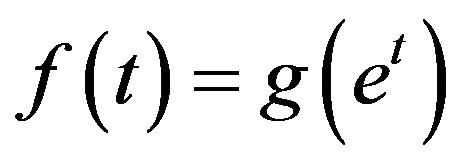 for all
for all . Then it holds that
. Then it holds that
 . (11)
. (11)
We need a lemma proved in Appendix B:
Lemma 2: 1)

for all . 2)
. 2)  is continuous and increasing on R.
is continuous and increasing on R.
Setting a* = f(1) − f(0) > 0 and b* = f(0), we will prove that f(t) = a*t + b* for all . Suppose that t is a rational number, i.e., there exists a pair of integers (p, q) such that
. Suppose that t is a rational number, i.e., there exists a pair of integers (p, q) such that
 . (12)
. (12)
Using the induction arguments with respect to  for a fixed p ≠ 0, it holds by Lemma 2 1) that
for a fixed p ≠ 0, it holds by Lemma 2 1) that
 (13)
(13)
Case 1 (t ≥ 0) Setting q = p in (13), we have that

Hence, we have by (13) and this that
 .
.
Since a* = f(1) − f(0) and b* = f(0), we have that
 .
.
Since  is continuous on R by Lemma 2 2), we have that
is continuous on R by Lemma 2 2), we have that
 .
.
Case 2 (t < 0) It holds by (12) that p < 0. Setting q = − p > 0 in (13), we have that

Hence we have by (13) and this that
 .
.
Since  by Lemma 2 1), we have that a* = f(0) − f(−1) > 0. Hence we have that
by Lemma 2 1), we have that a* = f(0) − f(−1) > 0. Hence we have that
 .
.
Since  is continuous on R by Lemma 2 2), we have that
is continuous on R by Lemma 2 2), we have that
 .
.
Thus it holds by (11) that  and that no function in LC represents
and that no function in LC represents .
.
Appendix B
Proof of Lemma 1 It holds that

Û 
Û 
Û 
Û 
for all .
.
Proof of Lemma 2 1) Since  satisfies the three axioms, it holds by Lemma 1 and (10) that
satisfies the three axioms, it holds by Lemma 1 and (10) that
 (14)
(14)
For any , set x* = eα, y* = eβ, z* = eγ and w* = eδ. Then we have by (14) that
, set x* = eα, y* = eβ, z* = eγ and w* = eδ. Then we have by (14) that

It holds by this and (11) that

2) Since g(x) is (strictly) increasing on X by (10), and since et is (strictly) increasing on R, f(t) ≡ g(et) is (strictly) increasing on R. Hence it holds by [14] Chapter 5 Theorem 3 p.100 that there are at most countable number of points at which f is not continuous. Thus there is a point α in R at which f is continuous. Let β be a point in R, and let {βm} be a sequence in R converging to β. Define a sequence {αm} in R by
 .
.
Hence we have Lemma 2 1) that
 .
.
Since limαm = α and f is continuous at α, we have that
 .
.
NOTES
2Namely the following three statements for a (rational) level comparison relation R on positive income levels are mutually equivalent: 1) the relation R satisfies the monotonicity axiom, i.e.,  and not yRx; 2) the relation R is represented by the logarithmic function, i.e.,
and not yRx; 2) the relation R is represented by the logarithmic function, i.e., ; 3) the relation R is represented by any function in M and no function in MC represents R, where M is the set of all increasing functions on the income levels.
; 3) the relation R is represented by any function in M and no function in MC represents R, where M is the set of all increasing functions on the income levels.
3In the literature of psychophysics, almost the same hypothesis called Weber-Fechner law is assumed for deriving a logarithmic function to represent the relationship between the stimuli and sensations. For the Weber-Fechner law, see [8]. In case of the expected utility function, which is also determined unique up to positive affine transformations, almost the same hypothesis stated in a differential form is assumed by Bernoulli to derive the logarithmic utility function. For the derivation of logarithmic utility function based on Bernoulli hypothesis, see [9] Section 3 and [10] Historical Note 6 Classic logarithmic utility.
4For the cardinal utility theory based on the difference comparisons, see [11-13].